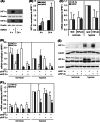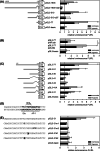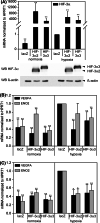Cell-specific and hypoxia-dependent regulation of human HIF-3α: inhibition of the expression of HIF target genes in vascular cells
- PMID: 21069422
- PMCID: PMC11115058
- DOI: 10.1007/s00018-010-0575-4
Cell-specific and hypoxia-dependent regulation of human HIF-3α: inhibition of the expression of HIF target genes in vascular cells
Abstract
Hypoxia-inducible factors (HIF) are transcription factors responding to reduced oxygen levels and are of utmost importance for regulation of a widespread of cellular processes, e.g., angiogenesis. In contrast to HIF-1α/HIF-2α, the relevance of HIF-3α for the regulation of the HIF pathway in human vascular cells is largely unknown. HIF-3α mRNA increases under hypoxia in endothelial and vascular smooth muscle cells. Analysis of HIF-3α isoforms revealed a cell type-specific pattern, but only one isoform, HIF-3α2, is hypoxia-inducible. Reporter gene assays of the appropriate promoter localized a 31-bp fragment, mediating this hypoxic regulation. The contribution of HIF-1/2 and NFκB to the HIF-3α induction was verified. Functional studies focused on overexpression of HIF-3α isoforms, which decrease the hypoxia-mediated expression of VEGFA and Enolase2. These data support the notion of a hypoxia-induced inhibitory function of HIF-3α and demonstrate for the first time the existence of this negative regulation of HIF-signaling in vascular cells.
Conflict of interest statement
None declared.
Figures









Similar articles
-
Prolonged fasting activates hypoxia inducible factors-1α, -2α and -3α in a tissue-specific manner in northern elephant seal pups.Gene. 2013 Sep 10;526(2):155-63. doi: 10.1016/j.gene.2013.05.004. Epub 2013 May 22. Gene. 2013. PMID: 23707926 Free PMC article.
-
Roles of the human hypoxia-inducible factor (HIF)-3α variants in the hypoxia response.Cell Mol Life Sci. 2011 Dec;68(23):3885-901. doi: 10.1007/s00018-011-0679-5. Epub 2011 Apr 10. Cell Mol Life Sci. 2011. PMID: 21479871 Free PMC article.
-
Multiplicity of hypoxia-inducible transcription factors and their connection to the circadian clock in the zebrafish.Physiol Biochem Zool. 2015 Mar-Apr;88(2):146-57. doi: 10.1086/679751. Epub 2015 Jan 14. Physiol Biochem Zool. 2015. PMID: 25730270 Review.
-
Regulation of the HIF-system in human macrophages--differential regulation of HIF-α subunits under sustained hypoxia.Mol Immunol. 2014 Feb;57(2):226-35. doi: 10.1016/j.molimm.2013.10.001. Epub 2013 Oct 29. Mol Immunol. 2014. PMID: 24176785
-
Progress on hypoxia-inducible factor-3: Its structure, gene regulation and biological function (Review).Mol Med Rep. 2015 Aug;12(2):2411-6. doi: 10.3892/mmr.2015.3689. Epub 2015 Apr 27. Mol Med Rep. 2015. PMID: 25936862 Review.
Cited by
-
Molecular mechanisms of hypoxia-inducible factor-induced pulmonary arterial smooth muscle cell alterations in pulmonary hypertension.J Physiol. 2016 Mar 1;594(5):1167-77. doi: 10.1113/JP270689. Epub 2015 Sep 30. J Physiol. 2016. PMID: 26228924 Free PMC article. Review.
-
Hypoxia-Inducible Factor-1α Target Genes Contribute to Retinal Neuroprotection.Front Cell Neurosci. 2017 Feb 27;11:20. doi: 10.3389/fncel.2017.00020. eCollection 2017. Front Cell Neurosci. 2017. PMID: 28289375 Free PMC article. Review.
-
Pro-inflammatory cytokines activate hypoxia-inducible factor 3α via epigenetic changes in mesenchymal stromal/stem cells.Sci Rep. 2018 Apr 11;8(1):5842. doi: 10.1038/s41598-018-24221-5. Sci Rep. 2018. PMID: 29643458 Free PMC article.
-
Hypoxia and Hypoxia-Inducible Factors in Leukemias.Front Oncol. 2016 Feb 26;6:41. doi: 10.3389/fonc.2016.00041. eCollection 2016. Front Oncol. 2016. PMID: 26955619 Free PMC article. Review.
-
AAV-based delivery of RNAi targeting ataxin-2 improves survival and pathology in TDP-43 mice.Nat Commun. 2025 Jun 25;16(1):5334. doi: 10.1038/s41467-025-60497-8. Nat Commun. 2025. PMID: 40562771 Free PMC article.
References
-
- Sluimer JC, Gasc JM, van Wanroij JL, Kisters N, Groeneweg M, Sollewijn G, Cleutjens JP, van den Akker LH, Corvol P, Wouters BG, Daemen MJ, Bijnens AP. Hypoxia, hypoxia-inducible transcription factor, and macrophages in human atherosclerotic plaques are correlated with intraplaque angiogenesis. J Am Coll Cardiol. 2008;51:1258–1265. doi: 10.1016/j.jacc.2007.12.025. - DOI - PubMed
MeSH terms
Substances
LinkOut - more resources
Full Text Sources
Molecular Biology Databases

